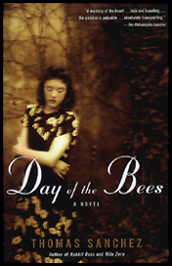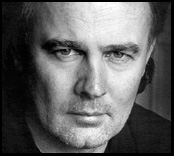more on day of the bees
Q: Where did you get the idea for DAY OF THE BEES?
A: One afternoon I had lunch in a small village in an isolated part of Provence
with an expatriate American woman. When the lunch was over, I asked my hostess if she knew of
a famous artist's muse who had lived in the village since the outbreak of the Second World War.
The rumor was that the woman had actually been cruelly abandoned there by the artist.
The expatriate assured me that the muse was not only alive, but lived next door.
"Then," I said, "you must be good friends?" The expatriate answered, "Oh no, she never speaks to me,
never speaks to any women. She speaks only to men--three men: the grocer, the pharmacist, and the
postman. She lives so close, and yet is such a larger-than-life-mystery."
This story stayed with me, and I often wondered what happened between the artist and his muse.
Why would a famous painter abandon such a young beauty? Why her reclusiveness over the years?
What if he had not abandoned her but she abandoned him? I became fascinated as to the truth; not
the historical reality of these two people, but the fateful consequence of their passion. What
fatal secrets were being concealed? What mythic events combined to abort such profound love?
During that summer in Provence I also became fascinated by the story of another woman. She had
arrived in France at the turn of the century, an orphan from Russia; her only identity, ironically
was a small crucifix on a chain around her neck (crucifixes were sometimes placed on orphaned
children who were smuggled out of Russia during this time to protect them from virulent anti-Semitism
). As a young woman, she was active in the French underground during World War II, the only woman
in her cell of Resistance fighters. The cell was betrayed, the men shot, and the woman crucified,
nails pounded through her hands to the door of the village church. This story fused in my mind with
that of the abandoned muse, and together they provided an emotional map for what became, after ten
years of writing, DAY OF THE BEES.
Q: DAY OF THE BEES is a dramatic departure from your previous novels. What led to this change?
A: My novelistic language is concerned with landscape, atmosphere, and architecture. In my novel, RABBIT BOSS, the landscape was immensely physical, a hundred-year history of a California Indian tribe played out in the majesty of the Sierra Nevada mountains. I had to use language to literally build those mountains in order for the stage to be set. In my novel, MILE ZERO, the setting is Key West, an island. Islands are fickle, ever-changing, subject to winds, tides, extreme temperatures. The language of MILE ZERO had to capture that atmosphere; it had to be ephemeralized, a heated-up place to explode human emotions. DAY OF THE BEES, on the other hand, is rooted in the landscapes of Provence and Mallorca, but its true architecture is the human heart, its desires, frailties, faults, and nobilities. Thus the language was a departure for me in that I wanted a straight line to the heart--an emotional arrow of simplicity tipped with intense nuance.
Q: One can certainly draw comparisons between your fictional Spanish artist, Francisco Zermano, and Pablo Picasso, who was also quite famous for his female muses. Was this intentional?
A: Zermano is in that line of Spanish painters from Velázquez, to Goya, to Picasso; he is wind, fire, and earth; Herculean, protean, vulnerable, speaking in the tradition of passionate Spanish poetic tongues--from the classical Gongorra to the celebrators of the mundane and the sublime, Pablo Neruda and Federico García Lorca.
Q: Why do you think the idea of the muse continues to fascinate us? How would you define the muse?
A: The idea of the muse fascinates some people, repels others. It is an idea much debated, debunked, lamented, or heralded. How the muse is perceived in art, history, and life no longer fits into one rigid interpretation or smug translation. Let's get right down to it--what drives one to create? Is the muse a person or an ideal? Is the muse a prescribed aesthetic, or a released anarchic energy that atomizes and takes holy shape in something called a work of art? Its about perception and whose eye perceives it.
Q: Bees (and in this case, a Bee Keeper) play a pivotal role in this book. What drew you to the idea of bees as a recurring presence throughout the novel? Does it have something to do with the idea of a society ruled by females?
A: For all the obvious reasons, the bees are what they are and what they are not. The text must be read closely, especially when Louise is saved from being gang-raped by a miraculous cloak of bees enshrouding her naked body. The bees become a multifaceted metaphor, they are a universal pollinating life force radiating from a hive, they also represent at a crucial turning point in the novel, the time in France of German occupation. Louise, in this instance, is France, a woman betrayed by her brethren, her body physically occupied by the enemy. The great calamity is that her child, the offspring of this Day of the Bees, is fathered both by her lover and her tormenter. She embodies the history of France at a specific moment.
Q: Why did you choose to tell a major part of this story through letters?
A: When I turned fifty, my mother gave me the love letters written to her by my father before his ship was torpedoed in World War II. What I first thought was that after fifty years, my mother could finally entrust the letters to me. Later I realized that wasn't the case. It took fifty years before she was emotionally capable of parting with the letters. It had to do with her, not me. Louise's letters are also "discovered" fifty years after they are written, their contents revealing the most personal acts, and illuminating with the candle of history the agony of living by choices one makes when young and in times of unrelenting duress. Louise knew that if her letters were received by her beloved Zermano in her lifetime, the emotions that had enabled them both to survive would be untethered, would tear free. The letters aren't so much a telling of the story as their existence proves they are the story.
Q: In reading the intimate, and often extremely erotic, letters between Louise and Francisco, one can't help but feel slightly voyeuristic. Was this intentional on your part?
A: All fiction is voyeuristic: the reader watches the author watching. But by using letters, I was able to slyly make of the reader a voyeur, an invader of privacy, a discoverer of secrets, since the themes of voyeurism, of privacy, of secrets kept and revealed, are so important to the book. And as we know, when secrets are present, violence is never far away, nor eroticism; thus, in the novel, the castle of the Marquis de Sade is not far from Louise's village.
Q: There has been much debate in the literary world about whether the private letters of public figures should remain private or be made available for public consumption. What do you think--or should the answer be clear by the actions of your narrator?
A: It is quite simple--a person with private letters who keeps and does not destroy them is implicitly sending them off to the future, to reside forever in the great ocean of public information.
Q: You have given us a love affair against a background of extreme violence and brutality. What do you see as the connection between love and violence, between art and war?
A: There is no act more violent to the self than to truly love another, let's
begin there. Some are brave and will open themselves up to the demolition of the heart for this
chance to embrace something utterly beyond the self. Others, just as brave but perhaps more boring,
keep themselves closed off, sealed from such calamity.
As to the connection between art and war, they say all sport evolved from war. If this is true,
then we can say that war follows art, as destruction follows creation. How can the greatest
creation, the human, become the greatest destroyer? Zermano faces this dilemma head-on,
acknowledging and accepting his baser instincts in order to defeat them with an act of violent
hope, a creative affirmation, for it assumes eyes will exist in the future to take the measure
of its meaning.
Q: What led you to make Ramón Llull, the 13th century mystic philosopher, an important influence in this novel?
A: It's interesting that Ramón Llull is enjoying a wave of rediscovery and
adulation in Europe, and is thought of as someone between Mick Jagger and Moses, as a philosophical
music-maker and radical thinker. What drew me to Llull was his history. As a young man he was a
spectacular seducer, a Don Juan who lived for passion, inspired by the physical beauty of women.
When the woman he finally loved was tragically stripped of her beauty, Llull's moment of truth came. He abandoned his love and fell from grace. After that, he renounced material goods and the pleasures of the flesh, and sought solace and forgiveness in messianic fervor. Ultimately he was stoned to death in North Africa while proselytizing to the Arabs that the Jews, Christians, and Muslims were all part of one universal religion.
To understand the soul of Zermano one must appreciate how his torment parallels that of Llull.
After Zermano loses Louise, he turns in his paintings to the subject of war and devastation; he is
seeking in a darkened world, a reflection of Louise's brilliant spirit to light his way back to
redemption. Zermano's redemption is not possible until he discovers the sacrifices Louise made in
her journey from the profanity of war to her sacred absolution of personal grace.
Q: Through Zermano's paintings, especially his, "Archangel Gabriel Flames Down the Sky," his personal "Guernica," you seem to be exploring the idea of how history and politics, and especially war, influence the art we create. How has this been true for your own work?
A: From my own personal history (losing my father to war before I was born, with all the consequences that wrought) it is evident that what wars inflict upon mankind influences my writing. But let's cross over now from the dark side of the street to the sunny side. In Mallorca, to this day, men don't greet each other with "Good day." Instead they ask, "How are the women?" In other words, if the women in your life are not well, then the world is not well.







